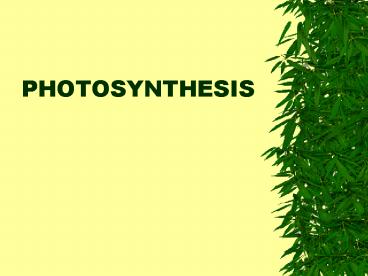PHOTOSYNTHESIS - PowerPoint PPT Presentation
1 / 24
Title: PHOTOSYNTHESIS
1
PHOTOSYNTHESIS
2
Chloroplast
3
(No Transcript)
4
- http//www.stolaf.edu/people/giannini/flashanimat/
metabolism/photosynthesis.swf
5
Chemiosmosis Production of ATP
- Requires a phospholipid bi-layer, a proton pump,
protons and ATP synthase. - Chemical Energy is used to pump protons through a
proton pump (intrinsic protein). This creates a
high concentration of protons (H) inside the
thylakoid disk. ATPase has a channel that allows
for the facilitated diffusion of protons back in
through the membrane. This activates ATPase,
which in turn catalyzes the formation of ATP.
6
(No Transcript)
7
- Creates a high concentration of protons (H)
inside the thylakoid disk. - ATPsynthase has a channel that allows for the
facilitated diffusion of protons back in through
the membrane. - This activates ATPsynthase, which in turn
catalyzes the formation of ATP.
8
Photosynthesis takes place in the leaves.
- The cells of the mesophyll layer of the leaf are
packed with chloroplasts. - Chloroplast filled with thylakoids stacked into
grana. (chlorophyll) - The grana are surrounded by the liquid stroma.
9
(No Transcript)
10
Photosynthesis Summary
- Light is captured from sunlight
- Light energy is converted to ATP and NADPH.
- Calvin cycle to form sugar.
11
1. Light Energy is Captured
- Photon strike (radiant energy on leaf)
- A photon is a tiny packet of radiant energy.
- Chlorophyll a and b (green), located in the
thylakoid membrane absorb light. Chlorophyll
loses electrons. - Carotinoids (yellow and orange) absorb light.
- These pigments are arranged in photo-systems I
and II and boost electrons to a higher energy
state. - http//earthguide.ucsd.edu/earthguide/diagrams/abs
orption/absorption.html - http//deal.unl.edu/jbutler/netc/jable2.htm
12
(No Transcript)
13
(No Transcript)
14
(No Transcript)
15
Warm upPhotosynthesis
- Write the formula for photosynthesis.
- Where does photosynthesis take place in the
cellbe specific. - Light energy is converted into two molecules
_____and ____ - Water is split into _____, ____ and ___
16
Chemiosmosis and ATPpage 102
- Electrons provide the energy to pump H across
the membrane. Then H diffuse across the
membrane through the ATP synthase protein channel
to form ATP.
- e_ H proton
pump - e_ e_
H e_ - electron transport chain
- on thylk. membrane ATPsynthase
- ADP
ATP
- H
-
17
2. Light Energy is Converted to Chemical Energy
(cont.)
- Photons are absorbed by photosystem I and boost
electrons to a higher energy state. - Reducing power (?) page 103
- NADP NADPH This is the reduced form
that carries hydrogen and energy. - The ATP and NADPH are released into the stroma.
18
Diagram light energy conversion
e_
e_
- chlorop PSII
electron transport chain - chlorop.PSI ADP
ATP
- NADP
NADPH - H20
- 02 HHe_ e _
H
19
Wonderful Web
http//www.stolaf.edu/people/giannini/flashanimat/
metabolism/photosynthesis.swf
http//www.biology4all.com/resources_library/sourc
e/61a.swf
http//faculty.nl.edu/jste/noncyclic_photophosphor
ylation.htm
http//instruct1.cit.cornell.edu/Courses/biomi290/
MOVIES/OXYGENIC.HTML
20
3. Calvin Cycle
- ATP and NADPH are used to make sugar.
- Calvin cycle occurs in the stroma.
- Carbon fixation enzymes attach carbon atoms
from CO2 to build organic molecules.
21
3. Calvin Cycle continued
- CO2 enters the cycle and a carbon attaches to a
5-carbon compound (RuBP). - This 6 carbon compound splits into two, 3-carbon
compounds (PGA). - ATP energy and NADPH reduce PGA to form the
3-carbon PGAL. It is energized
22
3. Calvin Cycle (finished)
- PGAL goes through a series of changes to form
4-carbon and 5 carbon molecules. - OR.a sugar. 3 turns form 6 PGALS and 5 are
needed for RuBP and 1 for the sugar product. - The Calvin cycle is dependent on ATP and NADPH
23
Calvin Cycle Finale
CO2
6 C 3C PGA 3C PGA
RuBP 5 C
ATP ADP
ATP ADP
Calvin Cycle
5 C
NADPH NADP
4 C
PGAL 3C PGAL 3C
24
Wonderful Web
- http//www.science.smith.edu/departments/Biology/B
io231/calvin.htm - http//faculty.nl.edu/jste/calvin_cycle.htm































